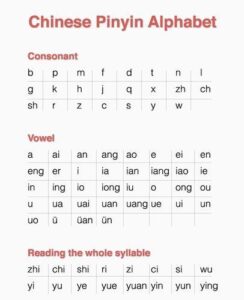
Learning Mandarin Chinese, with its unique characters and tonal pronunciation, can be an exciting yet challenging endeavor for beginners. Recognizing the need for accessible tools to aid early learners, a new resource has emerged: the “Beginner Chinese Pinyin Chart.” This visual guide aims to demystify the fundamentals of Chinese pronunciation, making the language more approachable for those just embarking on their linguistic journey.
Understanding the Challenge:
One of the initial stumbling blocks for Mandarin learners is mastering Pinyin, the phonetic system used to represent the sounds of the language using the Latin alphabet. Pinyin serves as the foundation for proper pronunciation and lays the groundwork for more advanced language skills. For beginners, navigating the nuances of tones and sounds can be overwhelming without proper guidance.
The Birth of a Learning Tool:
In response to this challenge, a team of educators and language enthusiasts collaborated to create the Beginner Chinese Pinyin Chart. This innovative tool is designed to provide a visual and interactive roadmap for learners, simplifying the process of grasping the intricacies of Mandarin pronunciation.
Visual Clarity and Intuitive Design:
What sets this Pinyin chart apart is its emphasis on visual clarity and intuitive design. The chart categorizes Mandarin sounds based on their initial consonants and finals, allowing learners to quickly identify and practice each sound. The incorporation of color-coded
elements enhance the visual experience, aiding in the memorization of distinct sounds and tones.
Interactive Features for Engaged Learning:
Beyond its static visual representation, the Beginner Chinese Pinyin Chart also offers interactive features. Users can click on each Pinyin symbol to listen to the correct pronunciation, allowing for a more immersive learning experience. This auditory reinforcement helps learners develop a more authentic and accurate pronunciation, a crucial aspect of mastering Mandarin.
Suitable for Various Learning Environments:
Whether used in a classroom setting or for self-directed learning, the Beginner Chinese Pinyin Chart adapts to different educational environments. Teachers can incorporate the chart into their lessons to reinforce pronunciation, while individual learners can utilize it as a reference tool during self-study sessions. The flexibility of this resource empowers learners to progress at their own pace.
Positive Feedback from Early Users:
Since its release, the Beginner Chinese Pinyin Chart has garnered positive feedback from both educators and learners. Users appreciate its user-friendly interface, clear audio samples, and the convenience of having a comprehensive guide in one accessible location. Many have reported increased confidence in their pronunciation skills after incorporating the chart into their learning routine.
Looking Ahead:
As the popularity of Mandarin Chinese continues to grow globally, tools like the Beginner Chinese Pinyin Chart play a crucial role in breaking down barriers to entry for language learners. With a commitment to ongoing improvement, the creators of this resource
are actively seeking user feedback to enhance its features and address the evolving needs of learners.
In conclusion, the Beginner Chinese Pinyin Chart emerges as a valuable asset for anyone embarking on the exciting journey of learning Mandarin. By combining visual clarity, interactive elements, and user-friendly design, this tool paves the way for a more accessible and enjoyable language-learning experience. Aspiring Mandarin learners can now embark on their linguistic adventure with confidence, armed with a powerful visual guide to navigate the complexities of Pinyin pronunciation.
